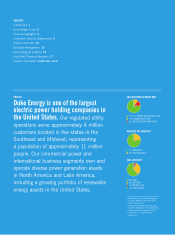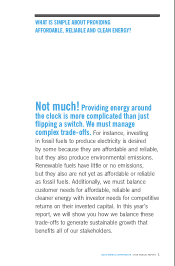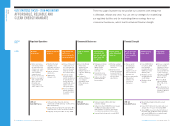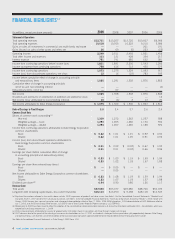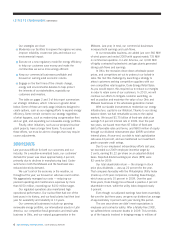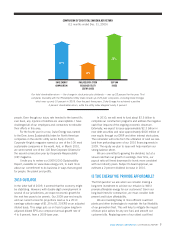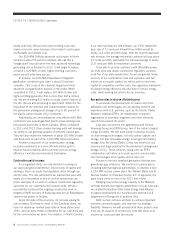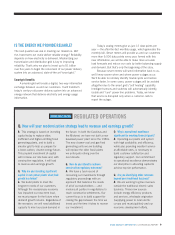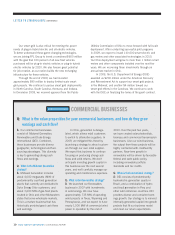Duke Energy 2009 Annual Report Download - page 12
Download and view the complete annual report
Please find page 12 of the 2009 Duke Energy annual report below. You can navigate through the pages in the report by either clicking on the pages listed below, or by using the keyword search tool below to find specific information within the annual report.
DUKE ENERGY CORPORATION / 2009 ANNUAL REPORT 11
Energy efficiency: A business model for the 21st century
The smart grid will become an important enabler for
more efficient energy use. It complements our goal to level
the playing field between incentives in place to promote
new plants and incentives needed to promote energy
efficiency investments. Most utilities today continue to
operate under regulatory frameworks created decades
ago that reward them for building new power plants and
distribution systems. They lack incentives to invest in
end-use energy efficiency.
Our energy efficiency plan takes steps toward creating
a framework that will allow us to earn a return on the costs
of new construction that we avoid due to the expansion of
end-use efficiency innovations. Over time, the growth in
energy efficiency programs is expected to smooth out the
demand for energy, making our demand less “peaky”
(less generation needed to meet peak loads). As a result,
customers’ overall energy costs would be reduced. The
cost of these programs will be recovered through a
nominal energy efficiency rate rider included in the
monthly energy bill.
First approved in Ohio in December 2008, our energy
efficiency framework was approved last year in North
Carolina, and in early 2010 in South Carolina and Indiana.
In Kentucky, we are evaluating a filing in late 2010.
IS THE ENERGY WE PROVIDE CLEAN?
Finally, to realize our mission we ask: Will the investments
we make provide cleaner energy?
Cleaner energy includes our investments in new,
more efficient and lower-emitting coal- and gas-fired power
plants, as well as the approximately $5 billion we have
invested over the last decade to significantly reduce sulfur
dioxide and nitrogen oxide emissions from our existing
coal fleet. We are also making significant investments in
renewable energy in both our regulated and commercial
businesses.
Including our renewables investments, our nuclear fleet
in the Carolinas and our hydroelectric assets in North America
and South America, we are now the third largest producer of
carbon-free electricity in the Americas among U.S.-based,
investor-owned utilities.
And we continue to reduce our carbon intensity, which
is the amount of CO2 emitted per unit of electricity produced.
Based on the latest available 2008 data, of the 20 largest
U.S.-based, investor-owned utilities, we rank 10th in carbon
intensity. In 2007, we ranked ninth.
Regulated renewables portfolio
Investing in renewable energy diversifies our fuel mix
and reduces our carbon footprint. In 2009, we were active
on many fronts to increase our renewable power portfolio.
To gain experience with the design, construction and
maintenance of distributed solar generation on our system,
last year we received approval from the North Carolina
Utilities Commission to construct solar power systems on
multiple customer properties. We brought our first system
under this program on line in early 2010 — a 1-MW system
with more than 5,200 solar panels on the roof of a large
manufacturing facility in North Carolina. We are on track
to construct a total of 8 MW of solar power systems by the
end of 2010. That is enough generating capacity to power
about 1,300 average-sized homes annually.
Last year, North Carolina’s policymakers put incentives
in place to support the creation of a state offshore wind
industry. As a result, we announced plans to construct
up to three offshore wind turbines to be sited in state waters
inside North Carolina’s Outer Banks. We are partnering
with the University of North Carolina on this initiative,
which could be the first wind turbines operating offshore
in the United States.
In addition to the direct investments we are making
to own solar and wind power in our regulated business,
we are also exploring blending wood chips with coal as a
supplemental fuel source that could reduce coal usage
at our existing power plants. We have conducted successful
trials of this process, known as biomass cofiring, and we are
developing plans to make it a major part of our renewable
energy portfolio.
We also continue to increase the amount of renewable
energy in our regulated portfolio through power purchase
agreements. In recent years, we have entered into contracts
to buy more than 170 MW of renewable energy, including
wind, solar, hydroelectric and landfill gas.
Commercial renewables business
Our commercial renewables business has initially
been focused on land-based wind energy, currently the most
economical renewable power source. By the end of 2010,
we expect to have nearly 1,000 MW of commercial wind
power in operation. We have been very successful in
bringing new wind projects on line ahead of schedule
and under budget. These projects are backed by long-term
contracts with creditworthy partners — a low-risk approach
that we are also applying to solar, biomass and new
transmission projects.


